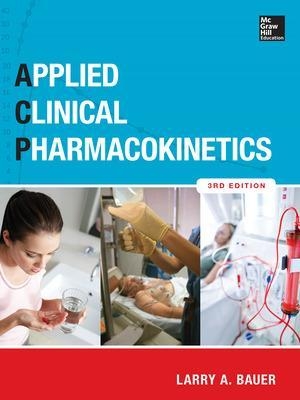
Applied Clinical Pharmacokinetics 3/E
McGraw-Hill Medical (Verlag)
978-0-07-179458-9 (ISBN)
Publisher's Note: Products purchased from Third Party sellers are not guaranteed by the publisher for quality, authenticity, or access to any online entitlements included with the product.
The most current, hands-on book in the field, Applied Clinical Pharmacokinetics The perfect textbook for pharmacy students learning the clinical application of pharmacokinetics, which is the mathematical tools for modifying doages. Students like that each chapter includes sample problems throughout the chapter, with a ton of practice problems at the end. Answers for the practice problems are in the back, but not detailed like the sample problems)
*Changes in the 3/e includes:
*All chapters updated and revised, as needed, including critical new references
*Antibiotic individualization and monitoring sections increases use of pharmacodynamic parameters (Cmax/MIC, AUC24/MIC, Time above MIC) in addition to pharmacokinetic parameters to adjust dosages
*Anticonvulsants section includes 5 new agents (Fosphenytoin, Lamotrigine, Levetiracetam, Oxcarbazepine, Eslicarbazepine)
*Immunosuppressants section includes 1 new agent (Sirolimus),
About the Book
Text focuses on the latest standardized techniques and approaches to patient-specific dosing and provides up-to-date information on more recently moniotored drugs.
Features
Clear, useful coverage of drug dosing and drug monitoring Clear and concise summary of pharmacokinetic and pharmacodynamic concepts
Practical help with calculations and equations
Focus on the latest standardized techniques and approaches to patient-specific dosing
Up-to-date information on more recently monitored drugs
Essential information on drug dosing in special populations, including patients with renal and hepatic disease, obesity, and congestive heart failure
All the information practitioners need on drug categories such as antibiotics, cardiovascular agents, anticonvulsants, and immunosuppressants
Full coverage of drugs such as Aminoglycosides, Vancomycin, Digoxin, Phenytoin, Carbamazepine, Theophylline, Cyclosporine, Tacrolimus, and Lithium Student friendly approach to teaching pharmacokinetics--sample problems embedded into the text to allow for students to apply what they are learing..
Larry A. Bauer, Pharm.D. is a Professor at the University of Washington School of Pharmacy and has been on the faculty since 1980. He also holds an adjunct appointment at the same rank in the Department of Laboratory Medicine where he is a toxicology consultant. He received his Bachelor of Science in Pharmacy degree (1977) from the University of Washington, and his Doctor of Pharmacy degree (1980) from the University of Kentucky. He also completed an ASHP-accredited hospital pharmacy residency (1980) specializing in clinical pharmacokinetics from A. B. Chandler Medical Center at the University of Kentucky under the preceptorship of Dr. Paul Parker. Dr. Bauer is a fellow of the American College of Clinical Pharmacology and the American College of Clinical Pharmacy. Dr. Bauer's specialty area is in clinical pharmacokinetics, and he teaches courses and offers clinical clerkships in this area. He is the author of Applied Clinical Pharamcokinetics (McGraw-Hill, 2001) His research interests include the pharmacokinetics and pharmacodynamics of drug interactions, the effects of liver disease and age on drug metabolism, and computer modeling of population pharmacokinetics. Dr. Bauer is a member of several clinical pharmacology and clinical pharmacy professional organizations. He is a reviewer for several scientific publications, was Consulting Editor of Clinical Pharmacy (1981 - 1990) and Field Editor of ASHP Signal (1981 - 1983), and is currently on the Editorial Boards of Clinical Pharmacology and Therapeutics and Antimicrobial Agents and Chemotherapy. Dr. Bauer has precepted post-doctoral fellows in clinical pharmacokinetics and pharmacodynamics who currently have faculty appointments in schools of pharmacy or are employed in pharmaceutical industry.
Part I. Basic Concepts
Chapter 1. Clinical Pharmacokinetic and Pharmacodynamic Concepts
Chapter 2. Clinical Pharmacokinetic Equations and Calculations
Chapter 3. Drug Dosing in Special Populations: Renal and Hepatic Disease, Dialysis, Heart Failure, Obesity, and Drug Interactions Part II. Antibiotics
Chapter 4. The Aminoglycoside Antibiotics
Chapter 5. Vancomycin
Part III. Cardiovascular Agents
Chapter 6. Digoxin
Chapter 7. Lidocaine
Chapter 8. Procainamide/N-Acetyl Procainamide
Chapter 9. Quinidine
Part IV. Anticonvulsants
Chapter 10. Phenytoin
Chapter 11. Carbamazepine
Chapter 12. Valproic Acid
Chapter 13. Phenobarbital/Primidone
Chapter 14. Ethosuximide
Chapter 15. Lamotrigine
Chapter 16. Levetiracetam
Chapter 17. Oxcarbazepine
Part V. Immunosuppressants
Chapter 18. Cyclosporine
Chapter 19. Tacrolimus
Chapter 20. Sirolimus
Part VI. Other Drugs
Chapter 21. Lithium
Chapter 22. Theophylline
| Erscheint lt. Verlag | 16.8.2014 |
|---|---|
| Zusatzinfo | 50 Illustrations |
| Verlagsort | New York |
| Sprache | englisch |
| Maße | 188 x 241 mm |
| Gewicht | 1458 g |
| Themenwelt | Medizin / Pharmazie ► Medizinische Fachgebiete ► Pharmakologie / Pharmakotherapie |
| Medizin / Pharmazie ► Pflege | |
| Medizin / Pharmazie ► Pharmazie ► PTA / PKA | |
| ISBN-10 | 0-07-179458-1 / 0071794581 |
| ISBN-13 | 978-0-07-179458-9 / 9780071794589 |
| Zustand | Neuware |
| Haben Sie eine Frage zum Produkt? |
aus dem Bereich


